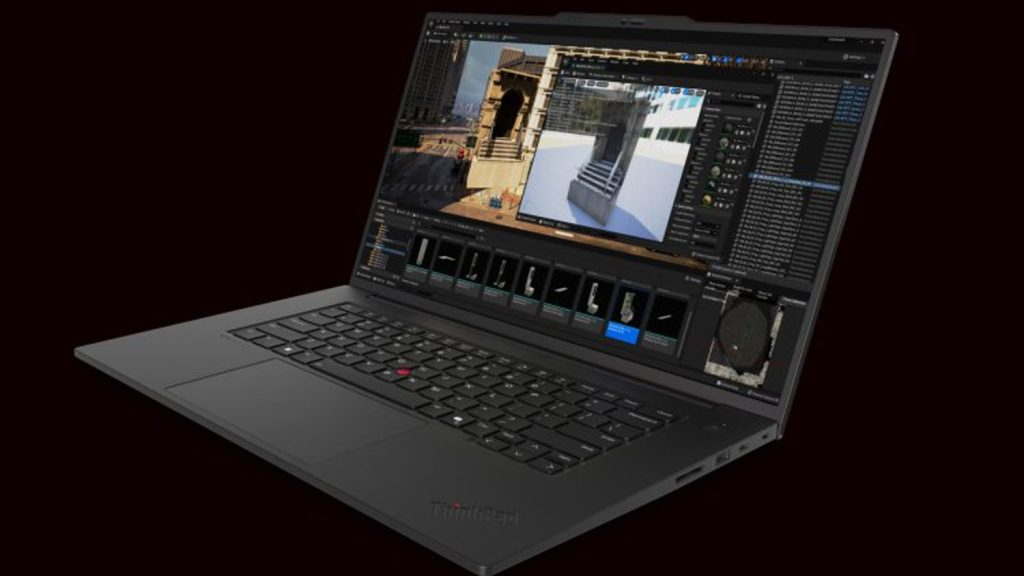Mobile workstation features Intel Core Ultra processor with NPU and Nvidia RTX pro GPU for AI workflows
Lenovo has introduced the ThinkPad P1 Gen 7, the latest version of its ‘ultraportable and high-performance’ mobile workstation. The 16-inch pro laptop features an Intel Core Ultra processor with an integrated neural processing unit (NPU) and a choice of Nvidia RTX Ada Generation GPUs, both of which can be used for AI processing.
According to Lenovo, the integrated NPU is dedicated to handling light, continuous AI tasks, while the Nvidia RTX GPU with Tensor Core technology is meant for more demanding day-to-day AI processing, including AI inferencing and training.
Beyond AI, most engineers will likely use the laptop for CAD and entry-level visualisation workflows, taking advantage of the ray-tracing, and graphics capabilities of the Nvidia RTX GPU.
The ThinkPad P1 Gen 7 comes with a choice of processors up to the Intel Core Ultra 9 185H and either the Nvidia RTX 1000, 2000 or 3000 Ada Generation GPUs.
Notably, the laptop cannot be configured with the Nvidia RTX 3500 or 5000 Ada Generation GPUs, both of which were options in its predecessor, the ThinkPad P1 Gen 6.
In theory this could mean the ThinkPad P1 Gen 7 is not as fast as the ThinkPad P1 Gen 6 in certain GPU workflows and may offer less GPU memory, although Lenovo has not yet shared the full specifications.
Limiting the laptop to an Nvidia RTX 3000 Ada Generation GPU may have contributed to a slightly smaller chassis than its Gen 6 predecessor. The ThinkPad P1 Gen 7 comes in at 354.40 x 241.20 x 17.05mm compared to 359.5 x 253.8 x 17.3 mm for the previous generation.
The ThinkPad P1 Gen 7 features a ‘liquid metal’ thermal design designed to enhance cooling performance and long-term reliability.
Elsewhere, ThinkPad P1 Gen 7 is said to be the world’s first mobile workstation to include LPDDR5x LPCAMM2 memory, up to 64 GB. According to Lenovo, LPCAMM2, which is brought to market in collaboration with Micron, delivers one of the fastest energy efficient modular memory solutions for PCs. Lenovo states that it consumes up to 61% less active power and saves 64% of space compared to DDR5 SODIMM, by delivering higher bandwidth and dual-channel support within a single module.
The ThinkPad P1 Gen 7 is equipped with a 16-inch display boasting a 16:10 aspect ratio, narrow bezels providing a 91.7% screen-to-body ratio, and the choice to configure a 400nit UHD+ OLED touch screen, with 100% DCI-P3, Low Blue Light, HDR400 and Dolby Vision. For connectivity, there’s 2 x Thunderbolt 4, 1 x USB-C (10Gbps), 1 x USB-A (5Gbps), HDMI 2.1, Wi-Fi 7 and Bluetooth 5.3. The 90Whr battery is ‘customer replaceable’.
Other features include the discrete Trusted Platform Module (dTPM) to encrypt user data and a self-healing BIOS to restore earlier system settings, if required. The ThinkPad P1 Gen 7 has also undergone ‘rigorous MIL-SPEC testing’.
Lenovo has also launched three other mobile workstations with Intel Core Ultra processors and Nvidia RTX Ada Generation GPUs.
The Lenovo ThinkPad P16v i Gen 2 is designed to bridge the gap between entry-level and high-end mobile workstations. It offers ‘advanced cooling with a dual thermal outflow’ and support for up to the Nvidia RTX 3000 Ada Generation laptop GPU.
There’s also the Lenovo ThinkPad P16s i Gen 3 with a ‘thin and light’ 16-inch chassis, and the ThinkPad P14s i Gen 5, which is said to be one of Lenovo’s thinnest and lightest mobile workstations. Both pro laptops support up to the Nvidia RTX 500 Ada Generation laptop GPU which is more suited to CAD workflows.






